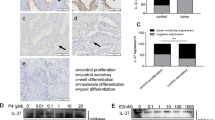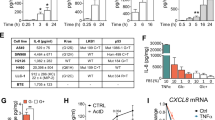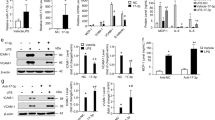Abstract
Recent studies have suggested that the expression of interleukin-8 (IL-8) directly correlates with the vascularity of human gastric carcinomas. In this study, the effect of IL-1β on IL-8 expression in human gastric cancer TMK-1 cells and the underlying signal transduction pathways were investigated. IL-1β induced the IL-8 expression in a time- and concentration-dependent manner. IL-1β induced the activation of extracellular signal-regulated kinases-1/2 and P38 mitogen-activated protein kinase (MAPK), but not the activation of c-jun amino-terminal kinse and Akt. Specific inhibitors of MEK-1 (PD980590) and P38 MAPK (SB203580) were found to suppress the IL-8 expression and the IL-8 promoter activity. Expression of vectors encoding a mutated-type MEK-1 and P38 MAPK resulted in decrease in the IL-8 promoter activity. IL-1β also induced the production of reactive oxygen species (ROS). N-acetyl cysteine (NAC) prevented the IL-1β-induced ROS production and IL-8 expression. In addition, exogenous H2O2 could induce the IL-8 expression. Deletional and site-directed mutagenesis studies on the IL-8 promoter revealed that activator protein-1 (AP-1) and nuclear factor (NF)-κB sites were required for the IL-1β-induced IL-8 transcription. Electrophoretic mobility shift assay confirmed that IL-1β increased the DNA-binding activity of AP-1 and NF-κB. Inhibitor (PD980590, SB203580) and ROS scavenger (NAC) studies revealed that the upstream signalings for the transcription factors AP-1 and NF-κB were MAPK and ROS, respectively. Conditioned media from the TMK-1 cells pretreated with IL-1β could remarkably stimulate the in vitro growth of HUVEC and this effect was partially abrogated by IL-8-neutralizing antibodies. The above results suggest that MAPK-AP-1 and ROS-NF-κB signaling pathways are involved in the IL-1β-induced IL-8 expression and that these paracrine signaling pathways induce endothelial cell proliferation.
This is a preview of subscription content, access via your institution
Access options
Subscribe to this journal
Receive 50 print issues and online access
$259.00 per year
only $5.18 per issue
Buy this article
- Purchase on Springer Link
- Instant access to full article PDF
Prices may be subject to local taxes which are calculated during checkout







Similar content being viewed by others
Abbreviations
- IL-8:
-
Interleukin-8
- AP-1:
-
activator protein-1
- C/EBP:
-
CCAAT/enhancer binding protein
- NF-κB:
-
nuclear factor-κB
- MAPK:
-
mitogen-activated protein kinase
- ROS:
-
reactive oxygen species
- Erk:
-
extracellular signal-related kinases
- JNK:
-
c-Jun NH2-terminal kinases
- NAC:
-
N-acetylcysteine
- DCFDA:
-
5-(and 6)-carboxyl-2′,7′-dichlorodihydrofluorescein diacetate
- CM:
-
conditioned media
References
Anthonsen MW, Andersen S, Solhaug A and Johansen B . (2001). J. Biol. Chem., 276, 35344–35351.
Baggiolini M, Moser B and Clark-Lewis I . (1994). Adv. Immunol., 55, 97–179.
Chen CY and Shyu AB . (1995). Trends Biochem. Sci., 20, 465–470.
Duval C, Cantero AV, Auge N, Mabile L, Thiers JC, Negre-Salvayre A and Salvayre R . (2003). Free Radic. Biol. Med., 35, 1589–1598.
Emrick MA, Hoofnagle AN, Miller AS, TenEyck LF and Ahn NG . (2001). J. Biol. Chem., 276, 46469–46479.
Folkman J . (1995). Nat. Med., 1, 27–31.
Ganesh S, Sier CF, Heerding MM, Van Krieken JH, Griffioen G, Welvaart K, Van de Velde CJ, Verheijen JH, Lamers CB and Verspaget HW . (1996). Cancer, 77, 1035–1043.
Ge B, Gram H, Di Padova F, Huang B, New L, Ulevitch RJ, Luo Y and Han J . (2002). Science, 295, 1291–1294.
Goede V, Schmidt T, Kimmina S, Kozian D and Augustin HG . (1998). Lab. Invest., 78, 1385–1394.
Guan Z, Baier LD and Morrison AR . (1997). J. Biol. Chem., 272, 8083–8089.
Guiraldes E, Duarte I, Pena A, Godoy A, Espinosa MN, Bravo R, Larrain F, Schultz M and Harris P . (2001). J. Pediatr. Gastroenterol. Nutr., 33, 127–132.
Harris GK and Shi X . (2003). Mutat. Res., 533, 183–200.
Heidemann J, Ogawa H, Dwinell MB, Rafiee P, Maaser C, Gockel HR, Otterson MF, Ota DM, Lugering N, Domschke W and Binion DG . (2003). J. Biol. Chem., 278, 8508–8515.
Hirschi KK and D'Amore PA . (1997). EXS, 79, 419–428.
Hofmeister R, Wiegmann K, Korherr C, Bernardo K, Kronke M and Falk W . (1997). J. Biol. Chem., 272, 27730–27736.
Jung YD, Fan F, McConkey DJ, Jean ME, Liu W, Reinmuth N, Stoeltzing O, Ahmad SA, Parikh AA, Mukaida N and Ellis LM . (2002). Cytokine, 18, 206–213.
Kasahara T, Mukaida N, Yamashita K, Yagisawa H, Akahoshi T and Matsushima K . (1991). Immunology, 74, 60–67.
Katsuyama K and Hirata Y . (2001). J. Biochem., 129, 585–591.
Kitadai Y, Haruma K, Sumii K, Yamamoto S, Ue T, Yokozaki H, Yasui W, Ohmoto Y, Kajiyama G, Fidler IJ and Tahara E . (1998). Am. J. Pathol., 152, 93–100.
Kitadai Y, Takahashi Y, Haruma K, Naka K, Sumii K, Yokozaki H, Yasui W, Mukaida N, Ohmoto Y, Kajiyama G, Fidler IJ and Tahara E . (1999). Br. J. Cancer, 81, 647–653.
Klezovitch O, Edelstein C and Scanu AM . (2001). J. Biol. Chem., 276, 46864–46869.
Kunsch C, Lang RK, Rosen CA and Shannon MF . (1994). J. Immunol., 153, 153–164.
Lo YY, Conquer JA, Grinstein S and Cruz TF . (1998). J. Cell. Biochem., 69, 19–29.
Maeda S, Akanuma M, Mitsuno Y, Hirata Y, Ogura K, Yoshida H, Shiratori Y and Omata M . (2001). J. Biol. Chem., 276, 44856–44864.
Mastronarde JG, Monick MM, Mukaida N, Matsushima K and Hunninghake GW . (1998). J. Infect. Dis., 177, 1275–1281.
Mukaida N, Morita M, Ishikawa Y, Rice N, Okamoto S, Kasahara T and Matsushima K . (1994). J. Biol. Chem., 269, 13289–13295.
Ochiai A, Yasui W and Tahara E . (1985). Jpn. J.Cancer Res., 76, 1064–1071.
Ohba M, Shibanuma M, Kuroki T and Nose K . (1994). J. Cell Biol., 126, 1079–1088.
Rennekampff HO, Hansbrough JF, Kiessig V, Dore C, Sticherling M and Schroder JM . (2000). J. Surg. Res., 93, 41–54.
Schwarz M, Radeke HH, Resch K and Uciechowski P . (1997). Kidney Int., 52, 1521–1531.
Shin EY, Kim SY and Kim EG . (2001). Exp. Mol. Med., 33, 276–283.
Singh RK and Varney ML . (2000). Histol. Histopatho., 15, 843–849.
Sizemore N, Leung S and Stark GR . (1999). Mol. Cell. Biol., 19, 4798–4805.
Straubinger RK, Greiter A, McDonough SP, Gerold A, Scanziani E, Soldati S, Dailidiene D, Dailide G, Berg DE and Simpson KW . (2003). Infect. Immun., 71, 2693–2703.
Thannickal VJ and Fanburg BL . (1995). J. Biol. Chem., 270, 30334–30338.
Wang M, Furuta T, Takashima M, Futami H, Shirai N, Hanai H and Kaneko E . (1999). J. Gastroenterol., 34, 10–17.
Welsh N . (1996). J. Biol. Chem., 271, 8307–8312.
Wolf JS, Chen Z, Dong G, Sunwoo JB, Bancroft CC, Capo DE, Yeh NT, Mukaida N and Van Waes C . (2001). Clin. Cancer Res., 7, 1812–1820.
Wu LL, Chiou CC, Chang PY and Wu JT . (2004). Clin. Chim. Acta., 339, 1–9.
Yasumoto K, Okamoto S, Mukaida N, Murakami S, Mai M and Matsushima K . (1992). J. Biol. Chem., 267, 22506–22511.
Acknowledgements
We are very grateful to Dr Eiichi Tahara (Hiroshima University, Japan) for TMK-1 cells, to Dr Natalie Ahn (University of Colorado, USA) for the MEK-1 construct and to Dr Jiahuai Han (Scripps Research Institute, USA) for the P38 MAPK construct. This work was supported by a grant (PF0320504-00) from the Plant Diversity Research Center of the 21st Century Frontier Program Funded by the Ministry of Science and Technology of Korean government.
Author information
Authors and Affiliations
Corresponding author
Rights and permissions
About this article
Cite this article
Hwang, Y., Jeong, M., Park, J. et al. Interleukin-1β stimulates IL-8 expression through MAP kinase and ROS signaling in human gastric carcinoma cells. Oncogene 23, 6603–6611 (2004). https://doi.org/10.1038/sj.onc.1207867
Received:
Revised:
Accepted:
Published:
Issue Date:
DOI: https://doi.org/10.1038/sj.onc.1207867
Keywords
This article is cited by
-
Inflammation and Neutrophil Oxidative Burst in a Family with NFKB1 p.R157X LOF and Sterile Necrotizing Fasciitis
Journal of Clinical Immunology (2023)
-
Enterotoxigenic Bacteroides fragilis activates IL-8 expression through Stat3 in colorectal cancer cells
Gut Pathogens (2022)
-
Vaccination with Mycoplasma pneumoniae membrane lipoproteins induces IL-17A driven neutrophilia that mediates Vaccine-Enhanced Disease
npj Vaccines (2022)
-
Reversible disruption of XPO1-mediated nuclear export inhibits respiratory syncytial virus (RSV) replication
Scientific Reports (2021)
-
Activation of NF-κB signaling via cytosolic mitochondrial RNA sensing in kerotocytes with mitochondrial DNA common deletion
Scientific Reports (2021)



